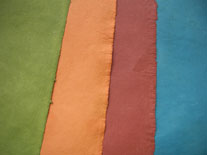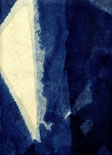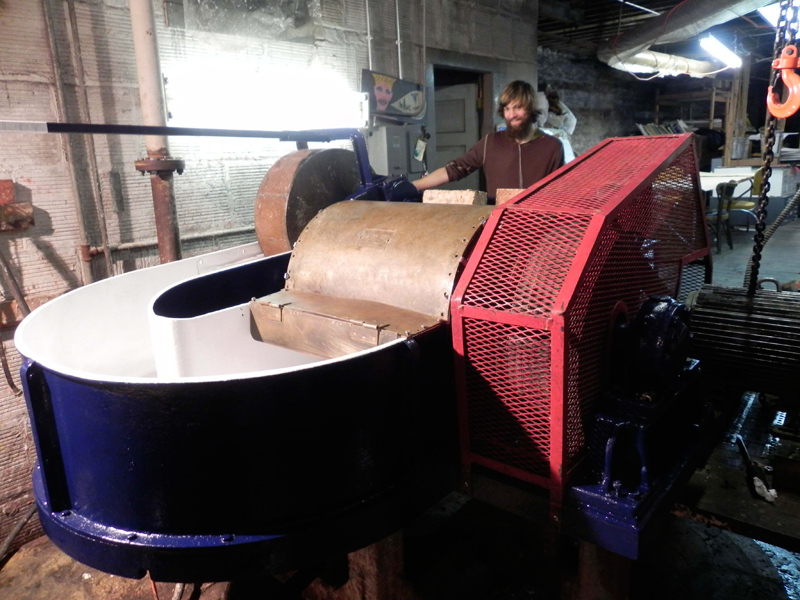


Welcome to Cave Paper
Cave Paper is a production hand-made paper mill dedicated to making decorated and unusual sheets of high quality for use by artists, bookbinders, calligraphers and anyone with a desire for fine sheets. Cave Paper is more than a location; our approach to making paper is as cave-like as the surroundings.
There is a certain rough elegance to the papers which is difficult to explain in words. It begins and ends with the raw materials. These include flax, cotton rag, and denim, along with natural dyes and pigments (black walnut, indigo and red iron oxide) to colour the sheets. Used individually and in combination with each other, they evoke in the viewer a sensuousness and connectedness with the earth. Perhaps they even remind us of our own mortality. For whatever reason they engage the senses, and thus our whole being. The beauty of these sheets exists independent of the maker. Our job is simply to listen, realise and put the parts together. The resulting sheets have a refinement and maturity, yet remain unpolished.
Follow this link to see the powerpoint Amanda gave about Cooperative Values at Friends of Dard Hunter meeting in
Atlanta, GA.
About Cave Paper
We are often asked why we chose the name 'Cave Paper'. If you saw the space you'd understand. Our basement workspace quite literally is a 'cave'. Arriving by freight elevator, one is note quite sure what land this is which has just been entered. The walls are hewn rocks, approaching boulders, and the space extends further than the light. Rooms are separated by arched doorways, with a maze of pipes and wires overhead, the floor is an unsteady mix of concrete, brick, and in some areas a wooden raised floor, giving way to the earth below. The final ingredient to the caveness of it all is the absence of windows.
Cave Paper officially began in June of 1994 when Bridget O'Malley moved back to Minneapolis and joined forces with Amanda Degener. Unofficially, Cave Paper began much earlier; for more than twelve years Amanda Degener has been building and acquiring equipment, vats, moulds and deckles, press, dryers etc. With Elaine Koretsky's donation of a 25 lb. beater to the Minnesota Center for Book Arts (MCBA) and the subsequent purchase of that beater by Amanda Degener, the stage was set for production papermaking to become a reality. With the assistance of her husband, Robert Hughes, Degener spent nearly a year reconditioning the beater and moving it to the current basement location in the Inkunabula Arts Building, in Minneapolis' warehouse district. The building also houses Campbell Logan Bindery, a limited edition and commercial bindery.
Amanda Degener became interested in papermaking while studying ceramics
and large scale sculpture. At Yale Graduate School she became increasingly
interested in the craft of handpapermaking and started using paper on her
large scale sculptures. She continued to study wherever opportunities arose
and slowly began to accumulate the tools necessary to set up a shop. She
built her own press and used a student loan to buy a used beater, designed
and built by Douglas Morse Howell. In July 1985, Degener moved her studio
to Minneapolis to become the first artist-in-residence at MCBA. It took
another month for water to be installed in the space, thus readied for
papermaking.
O'Malley and Degener first met in late 1985 at MCBA. Bridget O'Malley, a woodblock printer, had seen hand-made paper used in sculpture, yet had no real idea how it was made. She went to MCBA out of curiosity, was intrigued, and offered to do volunteer work in exchange for learning and assisting with classes. During the next two years, O'Malley continued to work with Degener at MCBA and also helped to install some of Degener's large scale paper works in exhibitions. In 1988, O'Malley decided to go to graduate school at the University of Iowa. Here she majored in printmaking with a strong focus on woodcuts, book arts and papermaking. For the next six and a half years Degener and O'Malley independently continued to learn more about papermaking. They remained in contact with each other throughout the years and rejoined in 1994 to begin Cave Paper. It is what they learned during those years apart which proved to be the basis of Cave Paper.

The Big Beater
This 25 lb Valley beater for pulping was originally worked on by Timothy Barrett, stored by Lee Scott McDonald, and before Amanda Degener bought it, it was owned by Elaine Koretsky then MCBA
During its almost 20 years of being the cornerstone of Cave Paper this beater has not been totally rehauled. Luckily recent college grad and former Cave intern James Kleiner returned from New Zealand where he built a small beater under the direction of Mark Lander.
Our new staff member James Kliener gave it a facelift: his adventure included welding, renting bearing pullers, priming then painting dozens of parts, and his methodical step-by-step reassembly. The nickname for this beater is now “the James”.
